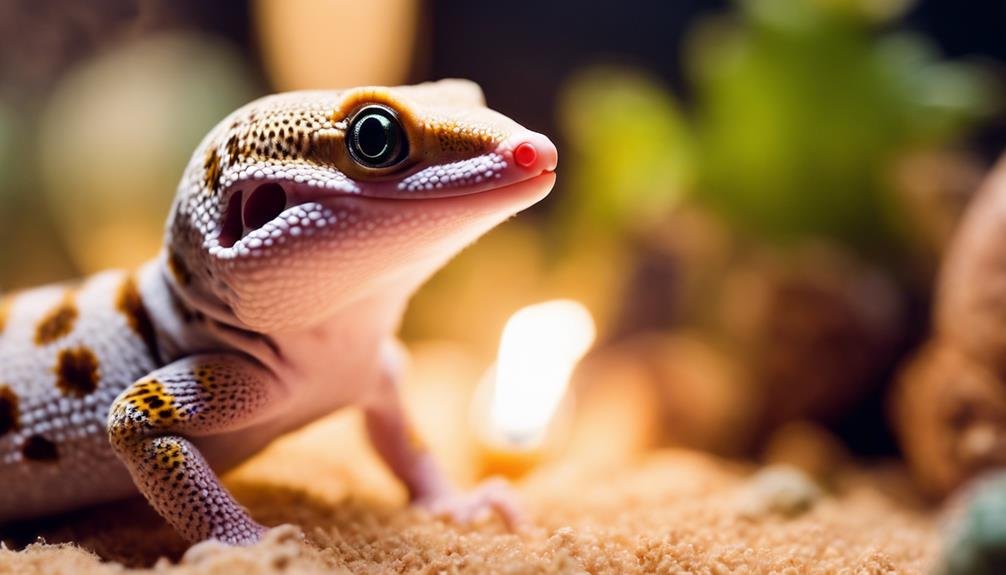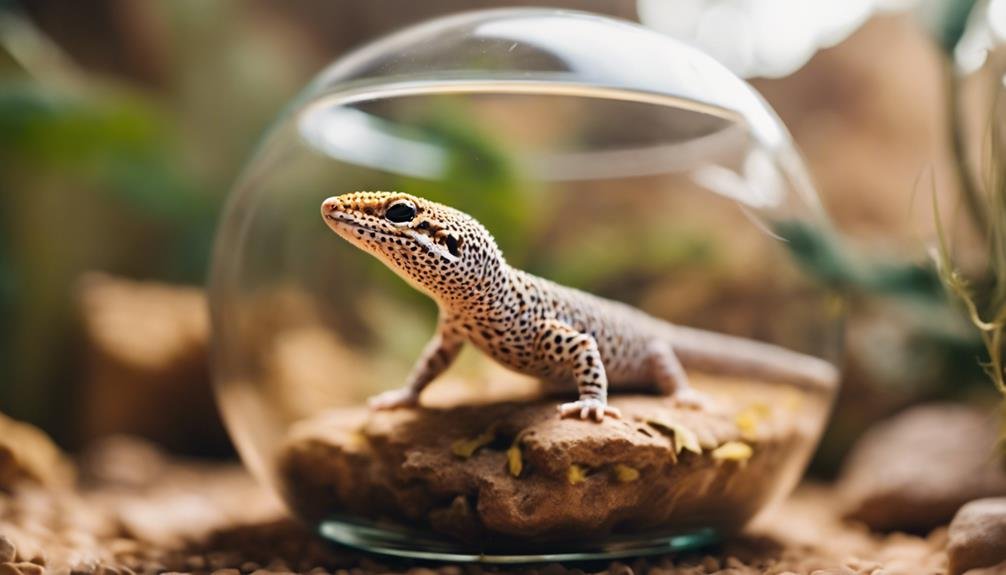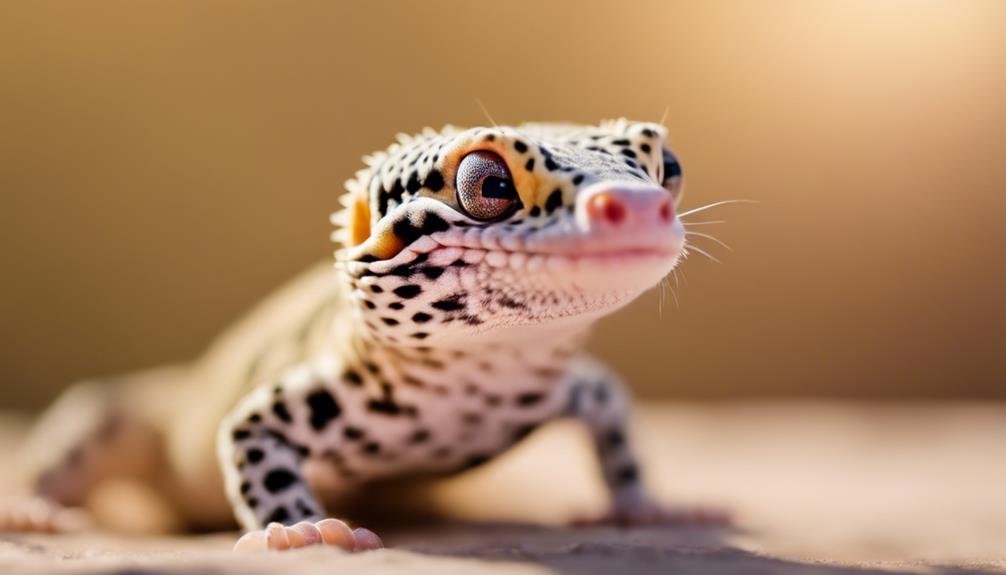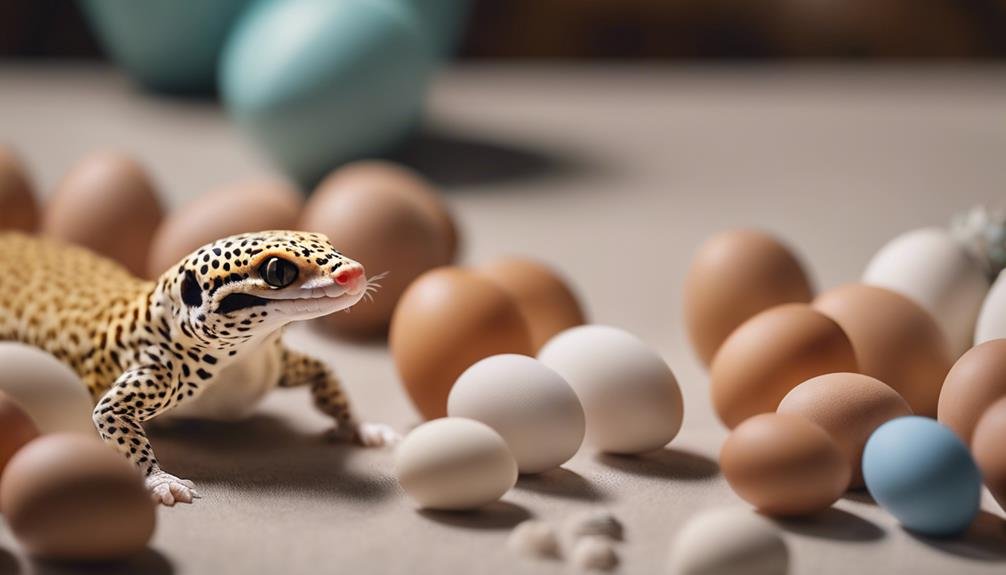If you're keen on ensuring your leopard gecko's health and preparing for the possibility of new life, understanding the signs of pregnancy is non-negotiable. You might've noticed changes in appetite or an unusual bulge, but there's more to it than meets the eye. Weight shifts, basking preferences, and even mood swings can all hint at your gecko's pregnancy. While some signs are more obvious, others require a keen observer. Let's explore these indicators more closely, so you don't miss out on the chance to provide the best care during this critical time.
Key Takeaways
- Noticeable surge in appetite indicates increased hunger due to pregnancy.
- Significant weight gain and visible egg bulges on the abdomen signal egg development.
- Increased basking behavior is crucial for egg nourishment and health during pregnancy.
- Nesting behavior, such as digging and rearranging habitat, prepares for egg-laying.
- Restlessness and frequent digging in the enclosure indicate imminent egg-laying.
Changes in Appetite
Have you noticed your leopard gecko's appetite suddenly spike? This could be a sign of pregnancy. Pregnant leopard geckos often experience significant changes in their eating habits, including an increased hunger that might catch you off guard. It's not just a slight uptick; we're talking about a noticeable surge in how much they're devouring. This abrupt shift towards higher food intake is a key indicator that your gecko might be gravid.
Monitoring your gecko's feeding patterns becomes important during this time. If you've been keeping a close eye on their diet and suddenly find yourself refilling their food dish more frequently, it's a strong hint that there might be more than one reason for their voracious appetite. Pregnant geckos display eating behaviors that are quite distinct from their usual routine. Whereas they might've been picky or moderate eaters before, pregnancy can turn them into quite the gourmands.
Understanding this change is essential. While it's exciting to think about the possibility of baby geckos, it's important to make sure that this increased appetite is indeed due to pregnancy and not a health issue. So, observing these significant changes in appetite is your first step in confirming whether your leopard gecko is expecting.
Weight Gain Observation
After observing changes in appetite, you'll also want to keep an eye on your leopard gecko's weight, as a noticeable increase can be another sign of pregnancy. Weight gain, especially if it's sudden or significant, may indicate the development of eggs inside her, signaling gravidity. This increase in body mass is a key sign you don't want to overlook.
To guarantee you're accurately tracking any potential pregnancy, here are three steps to follow:
- Monitor Regularly: Make it a habit to weigh your leopard gecko at consistent intervals. This will help you detect any unusual weight gain that could suggest she's gravid.
- Note Sudden Changes: An abrupt increase in weight, alongside other pregnancy signs, warrants closer observation. This could be the first clear indicator of gravidity.
- Seek Expert Advice: If you're unsure about the weight gain or its implications, consulting with a veterinarian who specializes in reptiles can provide clarity and guidance.
Increased Basking Behavior


Observe your pregnant leopard gecko closely as she may exhibit increased basking behavior, seeking additional warmth important for her developing eggs. This change in behavior is a natural response to her body's needs during this critical time. As the eggs develop, your gecko instinctively knows she requires more warmth to guarantee their healthy growth. You'll notice her spending more time under the heat lamp or in the designated basking spot, soaking up the warmth.
This basking behavior isn't just about comfort; it's important for her overall health and the development of her eggs. The warmth aids in digestion and metabolism, crucial processes that support her energy needs and the nourishment of her developing offspring. It's crucial to provide a suitable basking area with the right temperature gradients to accommodate her changing needs.
If you see your gecko basking more frequently, it's a sign she's preparing for egg-laying or regulating her body temperature to support egg development. Pay attention to these changes in basking behavior as they offer important clues to her health and well-being during pregnancy.
Visible Egg Bulges
As your leopard gecko's pregnancy progresses, you'll notice visible egg bulges on the sides of her abdomen, signaling the eggs' development. Observing these changes, alongside any behavioral shifts, is essential for understanding her health and preparing for the egg-laying stage.
It's important to distinguish these egg bulges from fat deposits to guarantee proper care and monitoring.
Identifying Egg Bulges
How can you tell if your leopard gecko is pregnant? Look for round, firm swellings on either side of the abdomen, known as visible egg bulges. These are a clear sign that your gecko is carrying eggs and is an essential indicator of a pregnant leopard gecko.
To better understand and monitor this condition, consider the following:
- Size Variation: The egg bulges may vary in size, which depends on the number and size of the eggs.
- Developmental Progress: As the eggs develop, these bulges become more pronounced, indicating how far along the pregnancy is.
- Consistent Monitoring: Regularly checking the size and appearance of these egg bulges can help you track the progress of your gecko's pregnancy, ensuring you're prepared for the next steps.
Behavioral Changes Observed
While the presence of egg bulges is a key indicator of pregnancy in leopard geckos, it's also important to note the behavioral changes that accompany this physical development. As the egg bulges become more visible, indicating gravidity, you'll need to closely monitor these changes to guarantee the well-being of your gecko.
| Sign of Gravidity | Behavioral Change |
|---|---|
| Visible Egg Bulges | Increased hiding or seclusion |
| Development Progress | Changes in appetite |
| Approaching Egg-laying | Restlessness |
These behavioral shifts are essential indicators of the stages of pregnancy. The visibility of egg bulges not only confirms that your gecko is carrying eggs but also helps you track the progress and prepare for the egg-laying period. Stay observant, as these changes are pivotal for managing gravidity effectively.
Health Implications Explored
Why should you pay close attention to the visible egg bulges in your leopard gecko? Recognizing these signs is crucial for providing the necessary care during the gravid period. Here's what you need to know:
- Visible egg bulges are round pinkish spheres around the middle of the abdomen, indicating the presence of developing eggs.
- As the gravid period progresses, the egg bulges may become more prominent, signaling that laying time is approaching.
- Health implications include the need for careful monitoring and adjustments in care to support your gecko through this critical time.
Understanding the significance of visible egg bulges ensures the well-being of your pregnant leopard gecko. It's essential for spotting any potential complications early and providing the best possible care during the gravid period.
Nesting Behavior
Nesting behavior signals a pregnant leopard gecko's preparation for egg-laying, involving activities like digging and rearranging their habitat to find the perfect spot. This instinctual behavior is your gecko's way of ensuring her future offspring have the best chance at survival. You'll notice she might become particularly interested in areas of her tank that offer seclusion or additional warmth, indicative of her search for the ideal nesting site.
Observing your gecko's actions closely, you'll see signs of her nesting behavior through frequent digging or burrowing in the substrate. It's a significant indication she's getting ready to lay her eggs and is trying to create a suitable environment for them.
To support her in this important phase, providing a moist hide filled with eco earth can make a significant difference. This not only mimics the natural nesting conditions she seeks but also encourages her to lay her eggs in a safe, controlled environment.
Restless Movements


As you've observed your pregnant leopard gecko, you might notice she's become more restless, pacing and digging in her enclosure. This behavior signals she's gearing up to lay her eggs, a natural part of her pregnancy journey.
Understanding why your gecko is restless and how to assist can guarantee she goes through the egg-laying process smoothly.
Identifying Restless Behavior
One telltale sign that a leopard gecko is nearing the time to lay her eggs is the onset of restless behavior, characterized by movements such as pacing, digging, or scratching at the substrate. This restless behavior isn't just random activity; it's a clear indicator that laying eggs is imminent. You'll notice:
- Pacing back and forth within the enclosure, indicating a search for the perfect laying spot.
- Digging or burrowing into the substrate more frequently, as if trying to create a nest.
- Scratching at the enclosure's floor or walls, which may signal discomfort or an attempt to escape to find a suitable nesting area.
Observing these behaviors provides valuable clues that your leopard gecko is about to lay her eggs, helping you prepare accordingly.
Causes of Restlessness
Understanding why your leopard gecko exhibits restless movements can help you better support her during the egg-laying phase. Restlessness in your pregnant leopard gecko often signals the nearing of the egg-laying period. This restless behavior isn't just random; it's a sign of discomfort or the gecko's instinctual search for the perfect spot to lay her eggs.
You'll likely notice digging behavior as she prepares for egg-laying, a natural part of her nesting process. To alleviate her restlessness, providing a moist hide or designated laying area is key. It's also essential to monitor this restlessness alongside other signs of gravidity, ensuring you're fully prepared to support her through the egg-laying process.
Frequent Digging
If your leopard gecko starts digging frequently, it's a strong indicator she might be preparing to lay eggs. This behavior isn't just random activity; it's an instinctual response for female geckos as they get ready for egg-laying. Observing your gecko's behavior closely can give you valuable insights into her health and needs during this critical period.
To support her, consider these steps:
- Provide a Moist Hide: A moist hide is essential for gravid geckos. It mimics the natural environment they seek out for egg deposition. By incorporating a moist hide in her enclosure, you give her a suitable place to dig and lay her eggs, making the process as stress-free as possible.
- Monitor for Other Signs: Frequent digging, when combined with signs like weight loss and restlessness, should prompt you to prepare for the arrival of eggs. These behaviors together signal that egg-laying is imminent.
- Understand the Behavior: Recognizing that digging is a natural nesting instinct for gravid geckos helps you to create the best possible environment for your pet during this time.
Mood Fluctuations


Have you noticed your pregnant leopard gecko acting more aggressive or irritable lately? This behavior isn't uncommon and can be attributed to mood fluctuations due to hormonal changes during pregnancy. It's fascinating yet challenging to see such a small creature go through significant changes that affect its behavior.
These hormonal shifts can lead to mood swings, making your gecko more prone to showing aggression or territorial behavior. You might find your normally docile pet suddenly hissing, biting, or displaying defensive postures when you try to handle her or even just approach her enclosure. This is her way of being protective during a vulnerable period.
Understanding that these mood fluctuations are a natural part of the pregnancy process is essential. It's a sign that her body is undergoing the necessary changes to ensure a successful birthing process. However, it's also important for you to monitor these changes closely. Excessive aggression or stress can impact both the mother's and the eggs' health. Adjusting your handling time, reducing stressors in her environment, and giving her extra space can help manage these mood swings and keep your pregnant leopard gecko healthy and safe.
– Can a Happy Leopard Gecko Show Signs of Pregnancy?
Yes, a happy leopard gecko can show signs of pregnancy. One of the telling leopard gecko happiness signs is weight gain, which can indicate that the gecko is pregnant. Other signs include changes in appetite, behavior, and nesting behavior. It’s essential to provide proper care and monitoring during this time.
Frequently Asked Questions
How Do I Know if My Leopard Gecko Is Going to Lay Eggs?
To know if your leopard gecko is about to lay eggs, look for pinkish spheres around its midsection, indicating ovulation. You might also see long, white ovals on its underside, signaling visible eggs. If it seems restless or loses appetite, it's likely close to laying. However, be cautious; fat pads can mimic gravid appearance.
With these signs, start preparing for incubation and keep an eye out for any egg-binding concerns.
How Can You Tell if a Leopard Gecko Is Pregnant?
To tell if your leopard gecko is pregnant, you'll notice not just physical changes but behavioral shifts too. They might start managing their body temperature more meticulously, moving between warm and cool spots more frequently.
You'll also see changes in their diet; their appetite might decrease as they get closer to laying eggs. Look for visible pinkish spheres or long white ovals in their abdomen, and watch for restlessness or a drop in food intake.
What Are Signs of a Happy Leopard Gecko?
To tell if your leopard gecko is happy, you'll notice a few clear signs. They'll have a hearty appetite, showing keen interest in their meals. You'll see them moving about their enclosure, engaging in active exploration. Their eyes are clear, their skin smooth, and they look well-cared-for.
They might wave their tail lightly when content. Happy geckos also enjoy basking or hiding as needed, displaying natural behaviors like hunting and exploring.
How Do I Know if My Leopard Gecko Is Sad?
If you're worried your leopard gecko is sad, watch for less obvious signs. They might hide more, show a drop in appetite, or act unusually like pacing a lot. Look out for weight loss or lethargy, too.
Gecko vocalizations and tail wagging aren't typical sadness signs, but changes in these behaviors could also signal distress. Keeping their environment comfy and engaging helps perk them up.
Conclusion
In sum, if you've noticed your leopard gecko showing signs like fluctuating appetite, packing on weight, basking more than usual, sporting egg bulges, nesting, restlessness, digging often, or mood swings, she might be pregnant.
Don't overlook these signs. They're your cue to prepare for egg-laying and guarantee your gecko gets the extra care she needs.
Staying alert to these changes can make a big difference in your gecko's health and happiness during her pregnancy.


